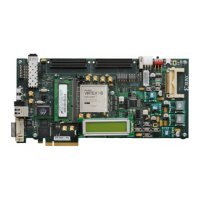Virtex-6 FPGA GTX Transceivers User Guide www.xilinx.com 215
UG366 (v2.5) January 17, 2011
RX Pattern Checker
Ports and Attributes
Table 4-29 defines the RX oversampling ports.
Table 4-30 defines the RX oversampling attributes.
RX Pattern Checker
Functional Description
The GTX receiver includes a built-in PRBS checker. This checker can be set to check for one
of four industry-standard PRBS patterns. The checker is self-synchronizing and works on
the incoming data before comma alignment or decoding. This function can be used to test
the signal integrity of the channel.
Table 4-29: RX Oversampling Ports
Port Dir Clock Domain Description
RXENSAMPLEALIGN In RXUSRCLK2 When this port is High, the 5X oversampler in the PCS
continually adjusts its sample point. When this port is Low,
it samples only at the point that was active before the port
went Low.
RXOVERSAMPLEERR Out RXUSRCLK2 When this port is High, the FIFO in the oversampling circuit
has either overflowed or underflowed. The PCS must be
reset to resume proper operation.
Table 4-30: RX Oversampling Attributes
Attribute Type Description
PMA_RX_CFG 25-bit Hex This 25-bit attribute allows the operation of the CDR to be
adjusted. In normal operation, set the attribute PMA_RX_CFG to
the default value generated by the wizard. In oversampling mode,
PMA_RX_CFG is set to 25’h0F44000.
RX_OVERSAMPLE_MODE Boolean This attribute enables receiver oversampling when TRUE and
when 5X oversampling is On.
RXPLL_DIVSEL_OUT Integer RXPLL_DIVSEL_OUT must be set to 1 when using oversampling
mode.
X-Ref Target - Figure 4-20
Figure 4-20: RX Pattern Generator Block
RXDATA
RXENPRBSTST
Error
UG366_c4_18_120809
Polarity
Inversion
SIPO
PRBS-7 Pattern Checker
PRBS-15 Pattern Checker
PRBS-23 Pattern Checker
PRBS-31 Pattern Checker
Error Counter
(16 bits)
RX_PRBS_ERR_CNT
RXPRBSERR

